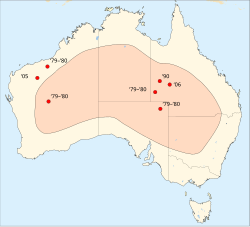| Pezoporus | |
|---|---|
 | |
| vocalising ground parrot | |
| Scientific classification | |
| Kingdom: | Animalia |
| Phylum: | Chordata |
| Class: | Aves |
| Order: | Psittaciformes |
| Family: | Psittaculidae |
| Tribe: | Pezoporini |
| Genus: | Pezoporus Illiger, 1811 |
| Type species | |
| Psittacus formosus [1] Latham, 1790 | |
| Species | |
 | |
Species distributions:
| |
| Synonyms | |
Geopsittacus | |
Pezoporus is a genus of parrot endemic to Australia. It contains two species: the night parrot (P. occidentalis) and the ground parrot (P. wallicus) which is divided into three subspecies. The night parrot was previously separated in a distinct genus, Geopsittacus. The genus is part of the tribe Pezoporini and subfamily Platycercinae.

